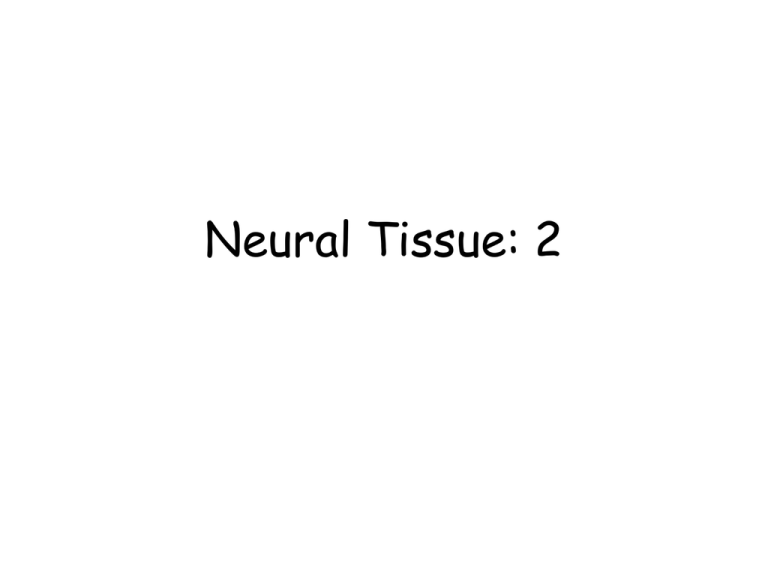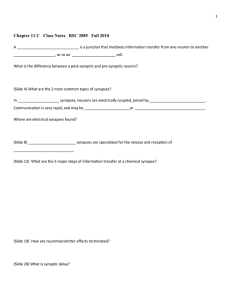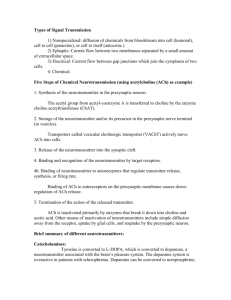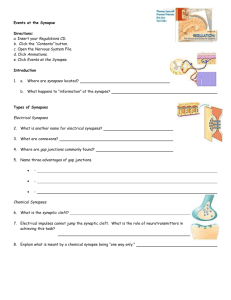Neural Tissue: 2
advertisement

Neural Tissue: 2 Terms to review • Action potential – – – – Depolarization Threshold Repolarization Hyperpolarization Can neurons continually fire? • No! • Refractory period: the time from the beginning of an action potential to the return of resting membrane potential – Absolute – Relative Can AP travel at different rates? • Yes! • Depends on presence of myelin around the axon; produces nodes – What kinds of cells are responsible for myelination in the CNS? PNS? • Depends on diameter of axon Continuous propagation Saltatory Propagation Saltatory Propagation Axons differ in diameter • Type A fibers – Large myelinated; carry CNS sensory for delicate touch, position and balance, and motor neurons • Type B fibers – Small myelinated; carry pressure, pain, temperature sensation info to the CNS and instruction to smooth, cardiac, and glands • Type C fibers – Small unmyelinated; carry sensory info to the CNS and instruction to smooth, cardiac, and glands The Synapse • Two kinds of synapses – Electrical: direct connections – Chemical: indirect connections Electrical Synapses • Occur in both PNS and CNS • Rare • Cells usually attached to each other by gap junctions • Promotes easy transfer of ions between two cells Chemical Synapses • Most common type of synapse • Response of the postsynaptic cell is dependent on the neurotransmitter AND the type of receptor found in cell membrane of the postsynaptic cell An example • ACh causes a depolarization in the membrane of skeletal muscles, BUT, ACh causes a transient hyperpolarization in cardiac muscle cell • Response to ACh depends on the receptor in the membrane of the postsynaptic cell! Acetylcholine • Synapses that release ACh are called cholinergic synapses – – – – Neuromuscular junctions of skeletal muscles Synapses in CNS Neuron-neuron synapses in PNS All neuromuscular and neuroglandular junctions in Parasympathetic Nervous System (division of the autonomic NS) What happens at a cholinergic synapse? Acetylcholine (ACh) • Two types of receptors bind ACh – Nicotinic – Muscarinic Other neurotransmitters • Biogenic Amines: derived from amino acids – Tyrosine is used to generate dopamine, norepinephrine, and epinephrine – Norepinephrine is found in the brain and Autonomic Nervous System – Dopamine regulates precise control of movement Other neurotransmitters • Biogenic Amines – Serotonin is synthesized from the amino acid tryptophan • Stabilizes mood; sleep and wake cycles – Histamine is synthesized from the amino acid histidine Other neurotransmitters • Neuropeptides – Substance P • Important in pain sensation – Opioids - inhibit release of Substance P • Endorphin = pain control • Opiates (morphine) bind to the same receptors as Substance P. Other neurotransmitters • Amino acids – Glutamate • Most important excitatory neurotransmitter in brain • learning and memory – Glycine • Inhibitory neurotransmitter • Strychnine (rat poison) blocks glycine receptors; results in fatal convulsions Neurotransmitters activate cells by 3 mechanisms • Direct effects – Acetylcholine (ACh) • Indirect effects – via G proteins – via intracellular enzymes Direct Activation Synaptic cleft Postsynaptic cell Indirect via G proteins Indirect via intracellular proteins Information Processing • Do I generate an AP? • How frequently do I generate them? • Postsynaptic potentials: Graded potentials that develop in post-synaptic membrane in response to neurotransmitter. EPSP & IPSP • Excitatory PSP: neurotransmitter causes depolarization (ACh causes Na+ to enter) • Inhibitory PSP: neurotransmitter causes hyperpolarization (K+ channels open) – Now, a LARGER than normal stimulus is required to produce an AP Summation Stimulus intensity




